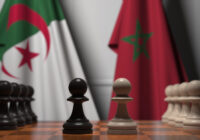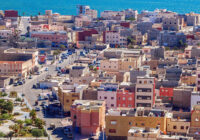Since early June, an estimated 15 to 26 million people across the United States have participated in protests against the death of George Floyd and the persistence of systematic racism in America. Recent trends have shown that support for the Black Lives Matter (BLM) movement — more than 67% — has doubled since 2016. Moreover, a majority of Americans favor working directly with black Americans to solve local issues.
Morocco Pays a High Price for Tourism Gentrification
As the US aims to improve race relations, black culture and heritage have become more than just an expression of the black community, but something that is inherently all-American. The BLM movement has highlighted the need for change in the US, and it may be helpful to consider the methods of Moroccan multiculturalism. In Morocco, cultural protection is tied to development, limiting socioeconomic divides and welcoming diversity.
A Model for the World
There is a word for the Moroccan ideal of multiculturalism — a term borrowed from the Spanish — known as convivencia (coexistence). Originally a reference to the relative harmony among Christians, Muslims and Jews living in Islamic Iberia (al-Andalus) during the Middle Ages, it now represents the shared history, culture and heritage of Morocco’s diverse national identity and a guide for modern multiculturalism.
Moroccan Judaism has roots in the time of antiquity. Jewish merchants came to Africa around 500 BC, likely to take part in the riches of the Carthaginian gold market. Before the Arab conquest, several native Amazigh (Berber) tribes converted to Judaism, one of which, located near Sefrou, survived long into the 11th century.
In 1948, about 265,000 Jews lived in the French and Spanish protectorates of Morocco, although the numbers soon began to decrease as many emigrated to newly-formed Israel. Those who remained resided mostly in small towns and villages, dispersed throughout the country, limiting their access to educational institutions and health care. The illiteracy rate for some Moroccan Jews was more than 40%.
When Morocco gained independence in 1956, after rising hostilities and anti-Jewish rioting in 1948, many Jews believed they had no future in a country where they felt they were unwelcome. However, despite these setbacks, Morocco has and continues to be protective of its Jewish community as a model for inclusion.
The 2011 amendment to the Moroccan Constitution redefined Moroccan national identity, establishing difference — Arab, Muslim, Jewish, Amazigh, Andalusian, African, Mediterranean — as a facet of Moroccan identity. It also made Tamazight, which is spoken by native Berbers, roughly one-third of the Moroccan population, an official language. And two years later, Morocco’s new migration policy regularized 24,000 migrants, beginning the first phase of a human-rights approach to migration and strengthening support of Morocco’s African heritage.
In combination with Morocco’s municipal charter — requiring participatory methods in community planning and thus involving minority voices — and the country’s stance within the UN Alliance of Civilizations (which ties multiculturalism to development), this solidified a tradition of multicultural preservation. This was a result of efforts by the late King Mohammed V and King Hassan II as well as the current monarch, King Mohammed VI.
The Role of Society
Morocco’s preservation of cultural heritage has led to greater community development and reduced poverty in neglected minority areas. Cultural preservation projects, funded by the ministry of culture in the Mellah of Marrakesh — a Jewish quarter whose traditional name was reinstated in 2017 — have restored streets and town squares, creating a safe, clean space for its inhabitants.
The House of Life project, initiated in 2010 by the chief rabbinate of Morocco and the ministry of interior, permits the restoration of 167 mausoleums and cemeteries in 14 different regions within Morocco. This has led to the development of pilgrimage destinations such as Ouezzane Cemetery in northern Morocco, where Jews of Moroccan descent who emigrated to Israel return to visit.
On lands surrounding these protected cemeteries, the High Atlas Foundation, a developmental organization in Marrakesh, creates nurseries for medicinal and fruit trees. These are then given to farmers as a way to diversify local produce and improve local economies, promoting both Jewish heritage and community development.
These projects are made possible through participatory methods, where members of the communities they serve decide which resources are most in need, a method that could be useful in underrepresented American neighborhoods. Promoting black art, culture and history gives recognition and provides a basis for the rest of the country to learn about differences.
“I always advocate for education,” says Laziza Dalil, a guest speaker on a series of Jewish-cross-cultural lectures hosted by the Kivunim Institute. “[Education] is a building bridge. It causes people to deal with diversity in a more positive way,” she adds. Dalil is also the vice president of the Association Mimouna, a Moroccan organization run by Muslim university students in the promotion of Jewish culture and tradition.
While the Moroccan case is not identical to the US, the development and support of a Moroccan multicultural society, through cultural preservation and promotion of minority visibility, can serve as a guide for NGOs and policymakers in America working to combat systemic racism. Such a plan may include funding the preservation of buildings and landscapes infused with black culture and history, supporting small museums or exhibitions on African American activism and achievement, and backing arts programs focused on diversity and inclusion.
The views expressed in this article are the author’s own and do not necessarily reflect Fair Observer’s editorial policy.
Support Fair Observer
We rely on your support for our independence, diversity and quality.
For more than 10 years, Fair Observer has been free, fair and independent. No billionaire owns us, no advertisers control us. We are a reader-supported nonprofit. Unlike many other publications, we keep our content free for readers regardless of where they live or whether they can afford to pay. We have no paywalls and no ads.
In the post-truth era of fake news, echo chambers and filter bubbles, we publish a plurality of perspectives from around the world. Anyone can publish with us, but everyone goes through a rigorous editorial process. So, you get fact-checked, well-reasoned content instead of noise.
We publish 2,500+ voices from 90+ countries. We also conduct education and training programs
on subjects ranging from digital media and journalism to writing and critical thinking. This
doesn’t come cheap. Servers, editors, trainers and web developers cost
money.
Please consider supporting us on a regular basis as a recurring donor or a
sustaining member.
Will you support FO’s journalism?
We rely on your support for our independence, diversity and quality.






